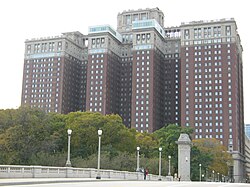Hilton Chicago
| Hilton Chicago | |
|---|---|

The Hilton Chicago
|
|
| General information | |
| Location | 720 S. Michigan Avenue Chicago, United States |
| Coordinates | 41.872499, -87.624357 |
| Opening | 1927 (as the Stevens Hotel) |
| Owner | Hilton Hotels Corporation |
| Technical details | |
| Floor count | 29 |
| Floor area | 2,054,590-square-foot (190,878 m2) |
| Design and construction | |
| Architect | Holabird & Roche |
| Other information | |
| Number of rooms | 1,544 |
| Number of suites | 90 |
| Number of restaurants | 3 |
| Parking | 510-car capacity parking garage |
| Website | |
| www3 |
|
The Hilton Chicago is a large centrally-located luxury hotel in Chicago, Illinois, United States. The hotel is a Chicago landmark that overlooks Grant Park, Lake Michigan, and the Museum Campus. It is the third-largest hotel in Chicago by number of guest rooms; however, it has the largest total meeting and event space of any Chicago hotel. The hotel has housed every president of the United States since its opening in 1927.
The hotel, designed in the Beaux-Arts architecture style, originally opened in 1927 as the Stevens Hotel, across Balbo Street from the older Blackstone Hotel. At the time, the Stevens was the largest hotel in the world. The hotel was developed by James W. Stevens, his son Ernest, and their family who ran the Illinois Life Insurance Company and owned the Hotel La Salle; James and Ernest Stevens are the grandfather and father, respectively, of former Supreme Court Justice John Paul Stevens. The Stevens featured 3,000 guest rooms, cost approximately $30 million to construct (more than ten times the cost of Yankee Stadium only few years earlier), and boasted of a virtual "City Within a City". The Stevens housed its own bowling alley, barber shop, rooftop miniature golf course (the "High-Ho Club"), movie theater, ice cream shop, and drug store. The first registered guest was Vice President Charles G. Dawes.
The Great Depression ruined the Stevens family, and the State of Illinois charged the hotel's owners with financial corruption. As with four out of five American hotels during the Great Depression, the Stevens Hotel went bankrupt. The government took the hotel into receivership, and by the late 1930s, it was valued at only $7 million. The youngest heir of the Stevens family was seven years old when the hotel opened. His legacy as John Paul Stevens would be to serve as a justice of the Supreme Court of the United States.
In 1942, the U.S. Army purchased the Stevens Hotel for $6 million for use as barracks and classrooms for the Army Air Force during World War II. The Stevens housed over 10,000 air cadets during this time, who utilized the Grand Ballroom as their mess hall. In January 1944, the War Department closed a deal to sell the property for $4.91 million to a bricklayer turned private businessman named Stephen Healy.
...
Wikipedia
